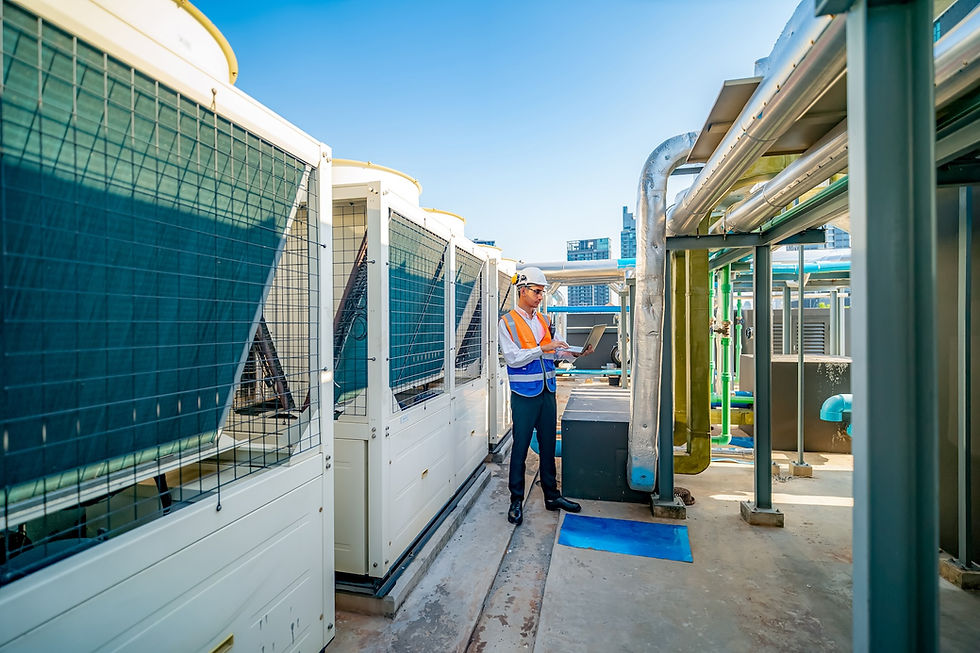A Step-by-Step Guide to Improving Indoor Air Quality and Reducing SBS Symptoms
- Jennifer Crowley
- Jul 11, 2024
- 4 min read
Updated: Jul 30, 2024

Improving Indoor Air Quality: The Importance of Addressing Sick Building Syndrome (SBS)
Sick Building Syndrome (SBS) is a significant concern in modern workplaces and living environments. Poor indoor air quality (IAQ) can lead to various health issues for occupants, including headaches, respiratory problems, fatigue, and cognitive impairments. Addressing SBS through better IAQ is crucial for ensuring the health and well-being of building occupants and maintaining a productive environment.
Assessment Phase: Evaluating Current Conditions and HVAC Systems

The first step in tackling SBS is to evaluate the current conditions of the building and its HVAC systems. This involves:
Air Quality Testing: Measure levels of common indoor pollutants such as dust, mold spores, VOCs, and carbon dioxide using professional-grade sensors and testing kits.
HVAC System Evaluation: Inspect the existing HVAC system for inefficiencies, outdated components, and potential areas for improvement. Check for signs of wear and tear and assess the system’s filtration and ventilation capabilities.
Building Inspection: Look for structural issues that could affect air quality, such as leaks, poor insulation, and areas prone to mold growth. This helps identify underlying problems that need to be addressed during the retrofit.
Choosing the Right Solutions:

Once the assessment is complete, it's time to choose the right solutions. Blade Air offers a range of advanced products designed to improve IAQ and mitigate SBS symptoms:
Pro Filters: These filters capture ultrafine particles, including viruses and bacteria, far exceeding the capabilities of traditional pleated filters. By removing these harmful particulates, Pro Filters help prevent respiratory issues, allergies, and asthma, ensuring cleaner and healthier indoor air.
HEPA+ Filters: Ideal for capturing up to 99.97% of airborne particles, including dust, pollen, and mold spores. These filters are especially beneficial for occupants with allergies or respiratory conditions, reducing symptoms like coughing, sneezing, and eye irritation.
UVGI Light Technology: This technology uses ultraviolet light to kill bacteria and viruses in the air, significantly reducing microbial contaminants and improving overall air hygiene. This is particularly effective in preventing infections and maintaining a healthier indoor environment.
Carbon Filters: Effective for removing odors and volatile organic compounds (VOCs), enhancing overall air quality and comfort by reducing exposure to harmful chemicals and improving the olfactory environment. Plus, minimize maintenance time and expenses with our patented revolutionary replaceable, zero waste carbon cartridge.
HEPA Air Purifiers: These portable units combine HEPA filtration with activated carbon to provide superior air purification in specific areas. They are perfect for targeted air quality improvements, ensuring that high-traffic or problem areas remain clean and safe.
Implementation: Installation and Integration

The implementation phase involves a step-by-step process of installing and integrating the chosen air quality solutions:
Preparation: Ensure the building is ready for retrofit activities by addressing any minor structural repairs identified during the assessment phase and performing a thorough cleaning of the HVAC system.
Professional Installation:
Pro Filters and HEPA+ Filters: While filter installation is relatively simple, Blade Air recommends having their expert team install the filtration products to ensure proper installation and provide training on installation and maintenance procedures.
UVGI Light Technology: Install UVGI light systems within the HVAC ducts or as standalone units in high-risk areas. This requires precise placement and calibration to ensure effective pathogen neutralization - professional installation is strongly recommended.
Carbon Filters: Integrate carbon filters into the HVAC system or place them in specific areas where odor control is needed.
HEPA Air Purifiers: Place HEPA air purifiers in strategic locations such as high-traffic areas, common rooms, and near HVAC intakes. Ensure they are plugged in and functioning correctly according to the manufacturer’s instructions.
System Connection: Connect the new filters and UVGI light systems to the existing HVAC controls, updating the HVAC control software or adding new control modules if necessary.
Testing and Calibration: Conduct thorough testing to ensure all components are working correctly and calibrate the settings to achieve optimal air quality. This includes adjusting UVGI light intensity and HEPA air purifier settings.
Optimization: Adjust the HVAC system settings to account for the new filters and purification devices, ensuring that airflow and ventilation rates are optimized for the enhanced filtration system.
Maintenance: Ensuring Long-Term Efficiency

Maintaining the new air quality systems is crucial for long-term efficiency and performance:
Regular Inspections: Schedule routine inspections to check the condition of filters, UVGI lights, and other components. Replace parts as needed.
Filter Replacement: Follow the manufacturer’s guidelines for replacing filters to ensure optimal filtration and prevent clogging.
System Calibration: Periodically calibrate the smart monitoring systems to ensure accurate air quality readings.
Cleaning: Keep the HVAC system and air quality devices clean to prevent dust buildup and maintain system efficiency.
Data Review: Regularly review air quality data to identify trends and potential issues, making informed decisions about maintenance and system adjustments.
The Importance of Immediate Action
Addressing SBS promptly is crucial for improving indoor air quality and safeguarding the health of building occupants for a productive, comfortable living or working environment. Blade Air is committed to providing cutting-edge air quality solutions that tackle SBS head-on.
By investing in Blade Air's Pro Filter technology and other advanced solutions like UVGI light technology and HEPA air purifiers, you can enhance indoor air quality, comply with regulatory standards, and promote overall well-being. Taking immediate action not only improves health outcomes but also ensures long-term efficiency and sustainability for your building. Contact Blade Air to learn more on how our technology can cure your sick building.

















